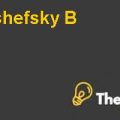Since, her approach to valuation has never been practiced in the industry so, it is a concern for her that how she should present her approach, and is there any benchmark, logical ground, or theory that could defend her approach when she present it to the conference.
2.0Analysis
2.1 Incentives for Martin
The incentive for Martin is her ranking in Institutional Investors magazine, and the revenues generated through the analysis.Martin. switched to sell-side from buy-side. The motivation for her to move to sell-side was the depth research required into the sell-side and the strong communication skills to communicate the results with the clients, and getting information from variousanalysts of different companies.She explained it as a 40% focus on analyzing the industry and stocks, 35% on communicating these analysis, and 25% on the internal CSFB constituencies and activities.
Her negative comments on the stocks would indicate that clients should sell the stocks because they are overvalued or the market conditions indicate a sudden drop down in the prices due to some variable changes analyzed based on the given information. Similarly, a positive recommendation to investors and clients is to buy or hold the underlying stocks even when they are undervalued, because their market value would proliferate based on the key industrial knowledge. Her analysis is stand alone in the market among others because of its in-depth look into the market.
2.2 Terminal value multiple
Terminal value refers to the long-term value of the company; it is calculated in the discounted cash flows analysis. The important variables in terminal calculation are growth rate, and discount rate because the terminal value is calculated as last year’s discounted cash flow divided by discount rate minus growth rate. The implied growth rate is estimated to be 4.4% since the perpetuate growth rate is 3%. See spread sheet or exhibit 1
If the implied growth rate changes the terminal value and the terminal multiple would also change. The current terminal multiple of Cox Communication stands at 13.5x EBIDTA. So, if the implied growth rate is 4.4%, then alternative terminal multiple is 9.68 see spreadsheet for calculations or see exhibit 1. On the other hand, change in terminal multiple would also bring change in the value of the firm. So, discounted cash flow value is $25,138 and outstanding shares are 565.2 million. Meanwhile, target price per share would be $44.48 per share. See spreadsheet, or the Exhibit 1.
2.3 DCF Model
The present value of discounted cash flow of Cox with the benchmark of Martin is $4,456, and present terminal value is $17,316 assuming that EBITDA would have a growth rate of 16% anda discount rate of 9.3%. So, overall value of the discounted cash flow is $30,687. So, it can be determined that if the growth rate declines to 8% from 16% then there would be many variations in the valuation process.
The present value of the company’s cash flowwould be $2455, and the present value of terminal value would be $6312.
This is just a sample partial case solution. Please place the order on the website to order your own originally done case solution.













